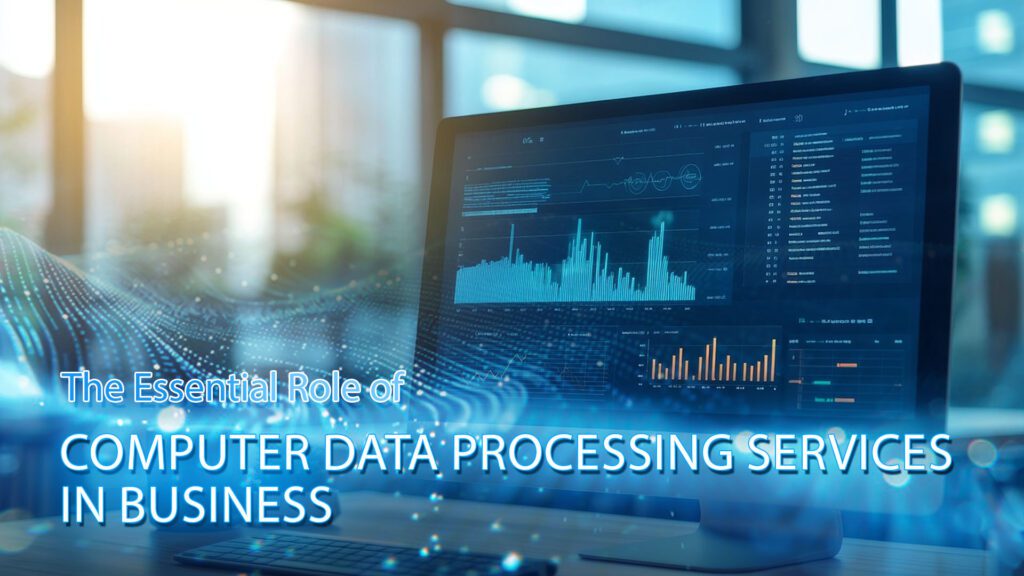Computer data processing services have become an inevitable rule for the operations of all fields in the modern context. In this article, DIGI-TEXX will go into detail to point out the importance of computer and data processing services and why businesses should pay attention and care to apply it. This will help your business optimize existing data sources and bring effective business strategies.
=> Read more: Exploring Data Processing Services: What You Need to Know

Overview of computer data processing services
What is computer data processing?
Computer data processing can be understood as the process of computers systematically processing data through specific operations such as calculating, comparing, arranging, classifying, and summarizing input data. This process converts raw data into meaningful information for analysis and decision-making.
Computer processing and data preparation and processing services providers typically follow a consistent sequence of operations that includes data collection, data validation, organization, summarization, aggregation, analysis, and reporting.
=> See more: Tips Improving Your Data Analysis Process
Computer data processing examples
Specific examples of the use of computer data processing are numerous in everyday business operations. Specifically, it can be visualized as follows:
- When a retail company analyzes sales data to forecast inventory needs, that company is performing data processing.
- When financial institutions process millions of transactions every day to detect fraudulent activities, they are performing computer data processing.
- Healthcare organizations use computer data processing to manage patient records, treatment plans, and payment information securely and efficiently, which can also be called computer data processing.

Other real-world examples include:
- Manufacturing companies use real-time production data to make judgments to optimize assembly line operations, such as minimizing unnecessary steps, changing the order of processes to bring better efficiency, etc.
- Logistics and delivery service providers will analyze shipment data to improve the efficiency of tracking customer orders.
- Marketing and communications departments process customer interaction data on websites and customer touchpoints to personalize marketing campaigns more effectively.
- Human resources departments analyze employee performance data to determine training needs, labor needs, and work environment support.
- Government agencies process census data to inform policy decisions for the coming years.
Each of these examples demonstrates how computer data processing services transform raw information into specific actions, driving operational improvements and optimizing outcomes for departments within the organization.
What are computer and data processing services?
Computer and data processing services are a set of services that include many specialized services that help businesses manage their information and data effectively. Including:
- Data collection and input: This step will collect information from many different sources and convert it into a digital format.
- Data cleaning and data validation: Identify incorrect data and correct errors, ensuring that the data is not duplicated and is consistent.
- Database management: This is an important step, helping to organize and maintain a structured data repository for analysis.
- Data storage and retrieval: Create a secure information storage method and provide an efficient and optimal access mechanism for data analysis.
- Data analysis and visualization: This step will apply statistical techniques and create charts to represent data.
- Generate and distribute reports on collected data: Generate and share summaries of processed data.
Manage and secure data used in reports: This step will provide information protection rules and ensure that parties with permission to interact with the data must comply with regulations.
The above are the basic steps of this service; in addition, computer programming data processing and integrated systems design services will expand on these steps by creating customized solutions that fit the specific business needs of each enterprise, often integrating multiple data sources and systems into the organization’s workflows. These services will combine software development, system architecture, and data science expertise to provide comprehensive solutions to solve complex business problems.
Additionally, when needed, businesses in Canada, Mexico or the United States can refer to this service at businesses with NAICS 541512 or NAICS 541513.
=> Read more: Data Cleansing Services for Accurate Insights
Streamline Operations with Reliable Address Validation Tools
Key Considerations for Choosing a Reliable Data Processing Services Provider
Have a data protection policy and compliance.
When choosing a computer data processing services provider, data protection should be a top priority. Providers must demonstrate that their security measures comply with relevant regulations such as GDPR, HIPAA, or CCPA, depending on the industry of the organization using the service. Ask providers about their security protocols, data encryption methods, and security certifications.

A breach of data security can lead to serious legal disputes, damage to reputation, and loss of customer trust. Therefore, it is extremely important to evaluate the security infrastructure of computer and data processing services providers. Look for providers who implement multiple layers of security, including:
- Security measures directly in their data centers
- Network security protocols and firewalls
- How data is encrypted in transit and at rest
- Access control mechanisms and authentication protocols
- Regular security audits and disaster testing
- Their incident response procedures
- Security training for on-site staff
An ideal provider will prioritize data protection as an integral part of their service rather than a secondary consideration.
Scalability and adaptability
As you can see, business needs are always changing, and so are computer processing and data preparation and processing services providers. It is also important to look for providers who can provide flexible solutions that can handle increasing volumes of data without sacrificing performance. Consider the following criteria for the adaptability of providers:
- Vertical Scalability: Can the service handle the increasing complexity of data?
- Horizontal Scalability: Can the infrastructure support increasing data volumes?
- Performance Scalability: Will processing speeds remain consistent as demand increases?
- Cost Scalability: How will the price of the service scale with growth?
The most effective computer data processing services will offer scalability options that match the trajectory of your business growth, allowing you to scale your data analytics without service disruption or a complete system overhaul and change.
Up-to-Date Technology
Modern computer programming, data processing and integrated systems design services should leverage the latest technologies available today, such as artificial intelligence, machine learning, and cloud computing. The advent of these technologies increases processing efficiency, improves accuracy, and enables more sophisticated data analytics that can give your business a competitive advantage.
When evaluating technology capabilities, consider the following key points:
- Cloud infrastructure ensures flexible resource allocation.
- AI and machine learning applications for data prediction and identification
- Edge computing for real-time processing capabilities
- Big data technologies for managing massive data sets
- Natural language processing for analyzing unstructured data
- Automation Workflow applications for streamlining operations
- API integration to connect to popular business systems
Good providers will continually invest in technological advancements that can provide more innovative solutions and better long-term value for your computer programming data processing and integrated systems design services needs.

Transparent Pricing
Pricing transparency is essential when evaluating computer data processing services. Avoid choosing a provider with a price list that has too many options or is unclear; such a provider can lead to additional costs that are outside the original budget. Good providers will always provide a clear, calculable price list that fits the expectations and budget set.
Key Pricing Criteria for Computer Data Processing Services:
- Usage-Based Pricing
- Pricing by Usage, Data Volume, or Processing Time
- Transparent Pricing for Basics and Advanced Add-Ons
- Project-Based Pricing for Custom Implementations
- Value-Based Pricing for Specific Business Outcomes
When requesting a quote, ask vendors to include any additional fees for additional services such as emergency support, system upgrades, or feature customization. Transparency in pricing will help you plan your budget accurately and prevent unexpected charges.
Outstanding Customer Support
Even the best computer and data processing services will need live technical support at some point. Assessing the quality of their customer support is a crucial step. It is important to look for providers who provide quick responses, multiple communication channels, and comprehensive documentation.

A good support provider for computer data processing services should ensure the following:
- 24/7 support for critical issues
- Multiple contact methods for support (phone, email, chat, website, social media)
- Clearly defined service level agreements (SLA)
- A dynamic and skilled team of experts
- Comprehensive documentation
- Regular service performance reviews and maintenance
- Proactive monitoring and incident prevention scenarios
A good support provider will ensure that any issues related to your computer programming data processing and integrated systems design services are resolved quickly, minimizing potential problems during the service usage.
=> Innovative Document Processing Companies for Modern Businesses
Benefits of Computer Data Processing Services for Businesses
Helps Automate Processes
Computer data processing services will often need to be integrated with automation technologies, reducing common human errors and speeding up data processing. Automated processes can run continuously, ensuring consistent data quality and reducing the time spent on repetitive tasks, allowing human resources to focus on more strategic tasks. For example, automated data entry can reduce errors by up to 90% compared to manual methods while processing information at significantly higher speeds.
The benefits of automation will last throughout the lifecycle of the data being mined:
- The organization’s data collection will become more systematic and comprehensive.
- Data cross-checking will automatically apply consistent rules without human supervision.
- Data transformation will follow standardized processes to ensure reliability.
- Helps analyze data continuously, identifying necessary information in real time.
- Generates automated reports on a pre-set schedule.
- Data storage complies with information security policies without human intervention.
By automating the data processing process, computer data processing services allow companies & organizations to process larger volumes of information while maintaining quality and consistency standards that would be impossible to achieve manually.
=> See more: Efficient Data Entry Solutions for Business Success
Enhance your organization’s data processing capabilities.
Computer processing and data preparation and processing services can process larger volumes of data than humans can efficiently, thanks to advanced hardware and software. Businesses will now be able to analyze more comprehensive data sets, uncovering insights beyond the limited capabilities of humans to process manually. Now, with data processing services, organizations and companies can process terabytes of information, making real-time analysis of streaming data from multiple sources no longer a distant and time-consuming, and labor-intensive task.
Proper and systematic data processing will bring competitive advantages to businesses as follows:
- More comprehensive analysis by using complete data sets instead of small data samples
- Analyze trends throughout the operating period and old data.
- Integrate multi-functional data to obtain comprehensive information & data about the business/organization.
- Can process structured and unstructured information simultaneously.
- Process data in real time to adjust business actions immediately.
- Multi-dimensional, multi-directional analysis to make predictions of many variables at the same time

Improving the data processing capacity of companies and organizations will help to bring out new information that cannot be exploited by manual data processing methods, promoting the ability to plan strategies and improve business operations more intelligently.
Advanced Data Security
Computer data processing services will typically have to provide very high security protocols, including data encryption and access control, to protect sensitive information of businesses & organizations. The security measures used are often more advanced than those implemented internally by small and medium-sized businesses, especially those with limited IT resources. Multi-layered security methods protect data at rest, in transit, and during processing, significantly reducing the risk of data leakage.
Professional computer and data processing services will all have to implement security measures, including:
- End-to-end encryption for data in transit and storage
- Access control and member authorization
- Tracking data interaction history, system interaction
- Ability to detect and prevent threats automatically
- Regular security updates and always have security patches.
- Hiding and securing sensitive data
- Data can be recovered from attacks and ensure service stability.
The commitment of providers to these features helps businesses to maintain business operations with peace of mind and helps protect valuable data from increasingly sophisticated threats from high-tech criminals.
Support for Advanced Analytics
Computer programming data processing and integrated systems design services should ensure that they provide the capabilities and tools to perform complex and in-depth data analysis, such as:
- Predictive analytics: Using enterprise data to predict future trends and behaviors
- Data mining: Supporting interactive tools so that users can examine data from both objective and subjective perspectives
- Real-time analytics: Continuously processing and analyzing data as new data is generated.
- Integrating machine learning capabilities: Algorithms should be able to improve the accuracy of analysis over time by learning from data patterns.
- Rational analytics: Systems should be able to evaluate text data based on context, style, and sentiment.
- Network analytics: Able to identify relationships between objects in complex data sets
- Anomaly detection: Automatically flag unusual data patterns that need to be clarified or removed.

By ensuring advanced analytics capabilities, services help businesses uncover hidden data, predict market changes, and find opportunities to optimize processes. By transforming data into actionable information, computer programming integrated systems design and data processing services help organizations make better decisions and develop effective business strategies.
How to Optimize a Computer Programming Integrated Systems Design and Data Processing Services
Assessing Needs
The first step in optimizing computer programming integrated systems design and data processing services is for vendors to conduct a thorough assessment of the specific requirements of the business. Before implementation, this assessment is critical:
- Current data volume and expected growth in the near future
- Types of data being collected and processed
- Speed and frequency of processing per day
- Organizational security policies
- Ability to integrate with existing systems
- How to report and visualize data
- Budget for implementation and ROI
- Organizational technical infrastructure
- Business goals that the data processing solution will address
A detailed assessment of needs will help avoid investing in unnecessarily complex solutions. This step will also ensure that computer programming integrated systems design and data processing services will be consistent with both the immediate requirements and the long-term strategic goals of the organization or company.
Choosing the right service
Selecting the right computer programming integrated systems design and data processing services requires evaluation based on the multiple providers and criteria outlined in the previous section. However, consider external factors such as the reputation and reach of the solution provider.
- Their technical capabilities and expertise
- Industry experience, especially in the area in which your organization operates
- Scale flexibility
- Security practices and security certifications
- How they communicate and customer testimonials
- Total cost of implementation, including deployment, maintenance, and warranty
- Innovation and technology investment roadmap
- Service pricing and other performance assurance criteria when deployed

A suitable service provider must demonstrate that they understand the customer’s business needs and can propose solutions that align with their strategic goals. Providers must position themselves as partners in the customer’s success, not just service providers.
Integration into Enterprise Systems
The effective implementation of computer programming integrated systems design and data processing services requires seamless integration with the existing technology infrastructure of the enterprise to be deployed. This process must be carefully planned to minimize disruption to ongoing operations within the organization. Consider the following factors:
- API compatibility
- Data transfer and replication
- Training & onboarding
- Pre-full deployment testing process
- Phased implementation for effective change management
- Can legacy systems be optimized?
- Data governance process
- How to design cross-departmental processes
- Change management planning
If integration is done well, it will ensure that data flows smoothly between systems and departments within the organization, eliminating silos and creating a unified data environment.
Measurement and Optimization
After implementation, computer programming integrated systems design and data processing services need to be continuously monitored and optimized to ensure their applicability to the business. Establish metrics such as KPIs to measure system performance, data quality, and its impact on the business. Regular assessments are needed:
- Bottlenecks in the process that need attention
- What steps can be automated?
- Changing business needs that require adjustments
- Cost optimization capabilities
- Updates on security and privacy regulations
- User acceptance and satisfaction after implementation
- How has data quality changed?
- Calculating ROI
Once the investment and implementation are successful, the step of measuring and monitoring optimization also plays a critical role in helping you know whether you have invested in the right place or not, thereby improving the organization’s work processes & performance.

Conclusion
Computer data processing services have become essential business tools in today’s data-driven economy. This article has provided an overview of the importance of data processing and what businesses can do today to make better decisions about their data processing in the future.
Are you ready to take full advantage of the potential of your business data? Contact DIGI-TEXX today to explore our custom computer and data processing services designed to meet your specific business needs.
=> You might like:


